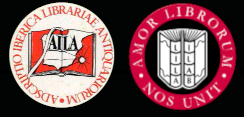


Home |
Temáticas |
Catálogos |
Pedidos |
  |  |
|||||||
|

|
RUGENDAS. (Johann Moritz) HABITANTE DE GOYAS, QUADRO A ÓLEO PINTADO SOBRE MADEIRA. |
|
|
Clique nas imagens para aumentar. ALVAREZ DE COLMENAR. (Juan) ANNALES D'ESPAGNE ET DE PORTUGAL,Contenant tout ce qui s’est passé de plus important dans ces deux Royaummes & dans les autres Parties de l’Europe, de même que dans les Indes Orientales & Occidentales, depuis l’établissement de ces deux Monarchies jusqu’à présent. AVEC La Description de tout ce qu’il y a de plus remarquable en Espagne & en Portugal. Leur Etat Present, leur Interets, la forme du Gouvernement, l’étendue de leur Commerce, & c. Par DON JUAN ALVAREZ DE COLMENAR. Le tout enrichi de CARTES GEOGRAPHIQUES, & de três belles FIGURES en Taille-douce. TOME PREMIER [+ TOME SECOND + TOME TROISIEME + TOME QUATRIEME]. A AMSTERDAM, Chez FRANÇOIS l’HONORÉ & FILS. M. DCC. XLI. [1741]. In 4º grande de 30x24 cm. Com xii, 424 + 288 + 331 + 340, [46] págs. Encadernação recente, inteira de pele ao gosto da época, com nervos e ferros a ouro na lombada. Ilustrados com mapas e gravuras em extratexto (contendo panoramas, costumes e trajes locais) abertos em chapa de metal (dita nesta obra “a talhe-doce”) com grande perfeição gráfica. Exemplar em grand-papier, com todos os volumes em barba, isto é, completamente por aparar inclusive à cabeça. Primeira edição francesa in 4º, a mais apreciada e mais procurada pelas suas dimensões e beleza do que a edição in 12º de 1725. Obra com a descrição geográfica e política de Portugal e da Espanha, contendo detalhes sobre a vida nas cortes e a história dos Descobrimentos dos portugueses e das Conquistas dos espanhóis. Aborda a história na Antiguidade e na Idade Média das províncias da Biscaia, Astúrias, Galiza, Leão, Castela-a-Velha, Andaluzia, Granada, Cádis, Múrcia, Valencia, Catalunha, Aragão, Navarra, as ilhas de Maiorca e Menorca, as seis províncias do reino de Portugal, uma descrição geográfica de Portugal e de Espanha, entre outras. A descrição de Portugal encontra-se na última parte do 3º volume e no início do 4º volume desta obra. Esta descrição de Portugal surge após a descrição da ilha e da história da Sardenha (que aqui também faz parte de Espanha). A descrição de Portugal em geral começa na página 223, antecedida por duas lâminas extratexto com quatro gravuras abertas em chapa: o mapa de Portugal e do Algarve com itinerários terrestres, a foz do Rio Minho, um mapa de Braga e uma vista de Coimbra. Segue-se a descrição dos arcebispados, das conquistas e das colónias portuguesas, na qual se inclui desde Ceuta e o Funchal até Nagasaki no Japão. Às divisões das províncias do continente e as suas dependências das capitais provinciais, seguem-se as descrições individualizadas das vilas e cidades a partir da página 232: Viana do Castelo, Porto, Guimarães, Braga, Miranda do Douro, Bragança, Lamego, Aveiro, Coimbra, Viseu, Guarda, Idanha, Tomar, Pedrógão, Leiria, Alcobaça, Peniche, Berlengas e Santarém. Segue-se Lisboa (com duas lâminas com quatro vistas da cidade), depois a descrição de Belém com outras duas lâminas extratexto com quatro vistas de Belém (o Palácio de Belém que o rei tinha adquirido, o perfil da costa até Cascais, a vista de Santo Amaro e da Ajuda e o Mosteiro dos Jerónimos). Seguem-se as descrições da cidadela de S. Julião da Barra, Sintra, Setúbal, da qual se apresenta um mapa juntamente com a Torre de Belém em Lisboa, e a vista de Évora e Estremoz e o mapa de Elvas, que são descritos em seguida. Segue-se a descrição de outras praças-fortes no sul de Portugal: Portalegre, Olivença, Vila Viçosa, Arronches (as três últimas com mapas extratexto) e ainda Moura, Serpa, Beja, Tavira, Faro, Silves e Lagos. A partir da página 298 até ao final deste volume da obra (pág. 331) apresenta-se uma espécie de roteiro turístico e cultural para quem viajar em Espanha e em Portugal. No início do 4º volume desta obra apresentam-se os usos e costumes civis, militares e religiosos em Portugal. Por exemplo a descrição das touradas das quais se mostra uma gravura com uma imagem de uma praça de touros em Lisboa, um Tribunal da Inquisição (o texto também apresenta um caso particular de um julgamento inquisitorial), os incriminados nos Autos de Fé, os uniformes das ordens militares religiosas (Santiago, São João de Ala, Cristo, etc) e novamente uma vista do Tejo durante um acontecimento social: o embarque real de Dona Catarina quando desposou o rei Carlos II de Inglaterra (em extratexto na pág. 132/133). Esta obra pesa mais de 5 Kg. e está sujeita a custos de porte adicionais.
Recent leather binding, in contemporary style, with raised bands and gilt tools on the spine. Illustrated with maps and hors-texte engravings (containing panoramas, habits and local costumes) etched in metal plate (said in this work to be "intaglio") with great graphic perfection. Copy in Grand-papier, with all volumes completely untrimmed including at the head. First French edition in quarto, the most appreciated and most sought after for its dimensions and beauty than the edition in duodécimo (twelvmo) of 1725. Geographical and political description of Portugal and Spain, containing details of life at the royal courts and the history of the Portuguese Discoveries and Spanish Conquests. It covers the history in antiquity and the Middle Ages of the provinces of Biscay, Asturias, Galicia, León, Old Castile, Andalusia, Granada, Cadiz, Murcia, Valencia, Catalonia, Aragon, Navarre, the islands of Majorca and Menorca, the six provinces of the kingdom of Portugal, a geographical description of Portugal and Spain, among others. The description of Portugal is found in the last part of the 3rd volume and the beginning of the 4th volume of this work. This description of Portugal comes after the description of the island and history of Sardinia (which here is also part of Spain). The description of Portugal in general begins on page 223, preceded by two hors-texte slides with four engravings etched on metal plate: the map of Portugal and the Algarve with land routes, the mouth of the River Minho, a map of Braga and a view of Coimbra. This is followed by a description of the archbishoprics, the conquests and the Portuguese colonies, ranging from Ceuta and Funchal to Nagasaki in Japan. The divisions of the provinces of the continent and their dependencies on the provincial capitals are followed by individualized descriptions of towns and cities starting on page 232: Viana do Castelo, Porto, Guimarães, Braga, Miranda do Douro, Bragança, Lamego, Aveiro, Coimbra, Viseu, Guarda, Idanha, Tomar, Pedrógão, Leiria, Alcobaça, Peniche, Berlengas and Santarém. This is followed by Lisbon (with two slides with four views of the city), then the description of Belém with another two hors-texte slides with four views of Belém (the Palace of Belém that the king had acquired, the profile of the coast as far as Cascais, the view of Santo Amaro and Ajuda and the Jerónimos Monastery). After this, descriptions of the citadel of S. Julião da Barra, Sintra, Setúbal, of which a map is given along with the Tower of Belém in Lisbon, and the view of Évora and Estremoz and the map of Elvas, which are described next. This is followed by descriptions of other strongholds in southern Portugal: Portalegre, Olivença, Vila Viçosa, Arronches (the last three with hors-texte maps) and also Moura, Serpa, Beja, Tavira, Faro, Silves and Lagos. From page 298 to the end of this volume of the work (p. 331) a kind of tourist and cultural itinerary is presented for those travelling in Spain and Portugal. At the beginning of the 4th volume, the civil, military and religious usages and customs in Portugal are presented. For example the description of bullfights of which an engraving is shown with an image of a bullring in Lisbon, a Trial of the Inquisition (the text also presents a particular case of an inquisitorial trial), those incriminated in the Autos de Fé, the uniforms of the religious military orders (Santiago, São João de Ala, Cristo, etc.) and again a view of the Tagus during a social event: the royal embarkation of Dona Catarina when she married King Charles II of England (hors-texte on p. 132/133). Referências/References: Palau I, 268 [ent. 9589]: «4 volumes. 4º mayor. 85 láminas. Tomo I, 2h. xii-424 p. 3 mapas plegados. Tomo II, 2h. 288 p. 46 láms. con 96 vistas. mapas, planos. Tomo III, 2 h. 331 p. 30 láms. con 63 vistas, y otra de Barcelona plegada. Tomo IV, 2h, 340 p. 23 h, 5 láms. con 10 vistas. 900 francos, Paris, en 1930. 200 pts. Barbazán, 1940.» Brunet I, 205 [25991]: « (trad. de l’espagnol par Massuet). Amst. 1741, 4 vol. gr. in 4º fig. 20 à 24 fr. Ved. 58 fr. mar. citr. La Serna. On a fait em même temps un éddition en 8 vols. in 12º, laquelle n’est pas plus chère que l’in 4º.» Inocêncio não refere, no entanto o autor é conhecido na bibliografia portuguesa pela sua História das Inquisições de Espanha e de Portugal / This work weighs more then 5 Kg. and is subject to aditional shipping costs. BN Paris 2, 738; Duarte de Sousa 1, 261 (refere a edição in 12º em 8 volumes / Referência: 1604NM026
Local: M-18-B-3 Caixa de sugestões A sua opinião é importante para nós. Se encontrou um preço incorrecto, um erro ou um problema técnico nesta página, por favor avise-nos. 
|
Pesquisa Simples




|
||
 |
|||
|